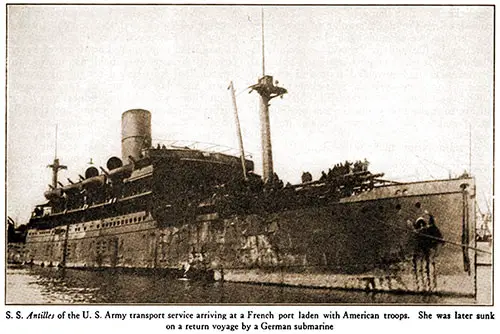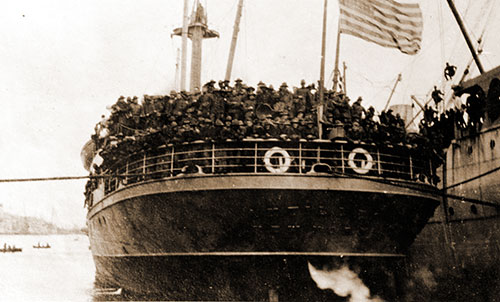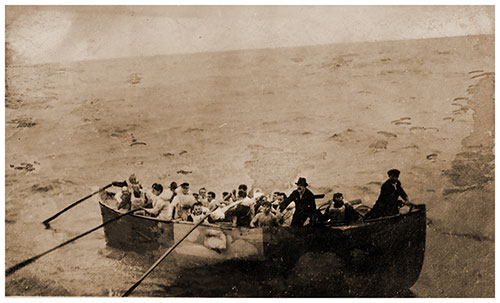Transport "Antilles" Sunk by Submarine - 1917

SS Antilles of the U. S. Army Transport Service Arriving at a French Port Laden with American Troops. She Was Later Sunk on a Return Voyage by a German Submarine. The United States in The Great War, 1919. GGA Image ID # 19336b7a5a
On October 17th, 1917, the first loss of an American transport, the Antilles, was torpedoed by a submarine about 300 miles west of Quiberon Bay. The ship sank four minutes after she was struck.
Sixty-seven lives were lost - 16 soldiers, 45 of the merchant crew, 4 of the naval gun crew, a civilian ambulance driver, and a negro stevedore.
''The Antilles had sailed from Quiberon with the Henderson and Willehad, the Corsair, Kanawha, and Alcedo acting as escort. Commander Daniel T. Ghent, the Senior Naval Officer on board, in a report gives this description of the sinking of the vessel:
"Just after daylight, a torpedo was sighted heading for us about two points abaft the port beam on a course of 45° with the keel. The torpedo was seen by the second officer on the bridge, the quartermaster and signalman on watch; by the first officer and first assistant engineer from the port side of the promenade deck, and by one of the gun crews on watch aft.
They estimated the distance from 400 feet to as many yards. Immediately on sighting the torpedo, the helm was put 'hard over' in an attempt to dodge it, but before the ship began to swing, the torpedo struck us near the after engine-room bulkhead on the port side.
The explosion was terrific; the ship shivered from stem to stern, listing immediately to port. One of the lookouts in the main top, though protected by a canvas screen about 5 feet high, was thrown clear of this screen and killed on striking the hatch. This case is sighted as indicating the power of the 'whip' caused by the explosion.
Guns were manned instantly in the hope of getting a shot at the enemy, but no submarine was seen.

The SS Antilles In a French Port with Troops on Board, Circa October 1917. Originally a American Passenger-Cargo Ship Built in 1907. While Operating as a Transport for the U.S. Army. On 17 October 1917, after Leaving France at the End of This Trip, Antilles Was Torpedoed and Sunk. Photo Courtesy of W. D. Porter, November 1937. Naval History and Heritage Command NH 57048. GGA Image ID # 180ad303e5
Men in Engine-room Killed
"The explosion wrecked everything in the engine room, including the ice machine and dynamo, and almost instantly flooded the engine room, fireroom, and No. 3 hold, which is just abaft the engine-room bulkhead.
The engine room was filled with ammonia fumes and with high-pressure gases from the torpedo, and it is believed that everyone on duty in the engine room was either instantly killed or disabled except one oiler. This man happened to be on the upper gratings at the time.
He tried to escape through the engine-room door near the level of the upper grating but found the door jammed and the knob on his side blown off.
Unable to force the door and to find the gases and ammonia fumes were overcoming him, he managed to escape through the engine-room skylight just as the ship was going under.
Within a few seconds after the explosion, the water was over the crossheads of the main engines, which were still turning over slowly.
Of the 21 men on duty in the engine room and firerooms, only three managed to escape. Besides the oiler, two firemen managed to escape through a fireroom ventilator.
The fact that the engines could not be maneuvered, and the headway of the ship checked added to the difficulty of abandoning ship.
"Just as the torpedo struck us, I was on the way to the pilothouse from the scene of fire. Before I could reach the bridge, the deck officer had sounded the submarine alarm, and I immediately sounded the signal for 'Abandon ship.
"The officer on watch, quartermaster, and signalman went to their boats. Radio Electrician Watson, being relieved by Radio Electrician Ausburne in the radio room, reported on the bridge for instructions.
I sent an order to get out an S. O. S signal. Radio Electrician Watson, who was lost, remained with me on the bridge until the gun crews forward were ordered to save themselves. He was wearing a life jacket and was on his way to his boat when I last saw him.
Good Order and Discipline Prevailed
"Before leaving port, all boats had been rigged out except the two after boats, which, owing to their low davits, could not with safety be rigged out except in favorable weather.
All other boats had been lowered to the level of the promenade deck. All hands had been carefully instructed and carefully drilled in the details of abandoning ship.
The best seamen in the ship's crew had been detailed and stationed by the falls; the gripes of each boat had stationed men, and all boats had been equipped with sea painters.
Two axes had been placed in each boat, one forward and one aft, for the purpose of cutting the falls or sea painters in case they should get jammed, and men had been detailed to cast them off.
That only 4 boats out of 10 succeeded in getting clear of the ship were due to several causes—the short time the ship remained afloat after being torpedoed.
The headway left on the ship, due to the fact that the engine-room personnel was put out of action by the explosion; the rough sea at the time; the fact that the ship listed heavily; and that the explosion destroyed one boat.
"When there was no one left in sight on the decks, I went aft on the saloon deck, where several men were struggling in the water in the vicinity of No. 5 boat and making no attempt to swim away from the side of the ship. I thought perhaps these men could be induced to get clear of the ship, as it was feared the suction would carry them down.
By the time that point was reached, however, the ship, being at an angle with the horizontal of about 45 degrees, started to upend and go down, listing heavily to port.
This motion threw me across the deck, where I was washed overboard. The ship went down vertically. The suction effect was hardly noticeable.
Gunners and Radio Men Stayed at Their Posts

Survivors from SS Antilles. A Boat Load of Survivors from the U.S. Army Chartered Transport Antilles, Photographed While Approaching Another Ship to Be Picked up. Their Ship Had Been Torpedoed and Sunk by the German Submarine U-62 on 17 October 1917, with the Loss of 67 Lives. Photo courtesy of Captain L.R. Leahy, USN. Naval History and Heritage Command NH 41744. GGA Image ID # 180acd4237
"The behavior of the naval personnel throughout was equal to the best traditions of the service. In charge of Lieutenant Tisdale, the two forward gun crews remained at their gun stations while the ship went down and made no move to leave their stations until ordered to save themselves.
Radio Electrician Ausburne went down with the ship while at his station in the radio room. When the ship was struck, Ausburn and McMahon were asleep in adjacent bunks opposite the radio room.
Ausburn, realizing the seriousness of the situation, told McMahon to get his life preserver on, saying, as he left to take his station at the radio key, 'Good-bye, Mac.' Later finding the radio room locked and seeing the ship was sinking, McMahon tried to get Ausburne out but failed.
"As soon as the Henderson saw what was wrong, she turned to starboard and made a thick smokescreen which completely hid her from view.
The Willehad turned to port and made off at her best speed. The Corsair and Alcedo returned to the accident scene and circled for about two hours when the Alcedo began the rescue of the survivors, the Corsair continuing to look for the submarine.
The total number of persons on board the Antilles was 234, the Corsair rescuing 50 and the Alcedo 117. Too much credit cannot be given to the officers and men of the Corsair and Alcedo for their rescue work and for their whole-heartedness and generosity in succoring the needs of the survivors. The work of the medical officers attached to the above vessels was worthy of the highest praise.
"An instance comes back, which indicates the coolness of the gun crews. One member was rescued from the top of an ammunition box, which by some means had floated clear and in an upright position.
"When this young man saw the Corsair standing down to pick him up, he semaphored not to come too close, as the box on which he was sitting contained live ammunition."
John Wilber Jenkins, "Transport 'Antilles' Sunk by Submarine," in Our Navy's Part in the Great War, New York: John J. Eggers Company, Inc., 1919, pp. 14-15.
